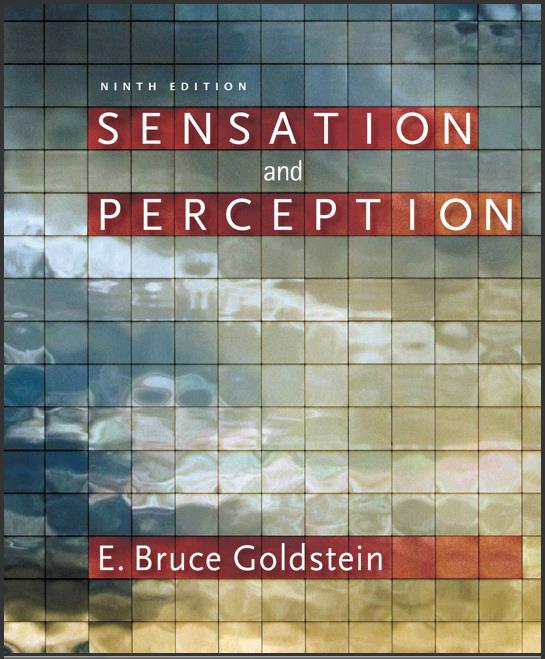Test Bank For Sensation and Perception 9th Edition by Bruce Goldstein ISBN 1133958494 978-1133958499
$70.00 Original price was: $70.00.$35.00Current price is: $35.00.
Instant download (Test Bank) Sensation and Perception 9th Edition by Goldstein after payment
Test Bank For Sensation and Perception 9th Edition by Bruce Goldstein – Ebook PDF Instant Download/Delivery: 1133958494, 978-1133958499
Full dowload Sensation and Perception 9th Edition after payment

Product details:
ISBN 10: 1133958494
ISBN 13: 978-1133958499
Author: E. Bruce Goldstein
Seeing and reading this sentence may seem like a “no brainer”–but your perception is just a tiny part of what is happening in your brain and body right now (both are much busier than you might think). SENSATION AND PERCEPTION has helped many readers understand the ties between how we sense the world and how the body interprets these senses. A key strength of this book has always been the ability to illustrate concepts through examples and visuals. Dr. Goldstein walks you through an intriguing journey of the senses, combining clear writing, his extensive classroom experience, and innovative research to create a visual, colorful book. Available with InfoTrac¬Æ Student
Sensation and Perception 9th Table of contents:
Chapter 1. Introduction to Perception
Why Read This Book?
The Perceptual Process
Stimuli (Steps 1 and 2)
Receptor Processes/Transduction (Step 3)
Neural Processing (Step 4)
Behavioral Responses (Steps 5–7)
Knowledge
How to Approach the Study of Perception
Measuring Perception
Measuring Thresholds
Estimating Magnitude
Beyond Thresholds and Magnitudes
Something to Consider: Threshold Measurement Can Be Influenced by How a Person Chooses to Respond
The Road From Here
Think About It
Key Terms
Media Resources
Chapter 2. The Beginnings of Perception
Starting at the Beginning
Light and Focusing
Light: The Stimulus for Vision
The Eye
Light Is Focused by the Eye
Loss of Accommodation With Increasing Age
Myopia
Hyperopia
Receptors and Perception
Transforming Light Energy Into Electrical Energy
Adapting to the Dark
Spectral Sensitivity
Electrical Signals in Neurons
Recording Electrical Signals in Neurons
Basic Properties of Action Potentials
Chemical Basis of Action Potentials
Transmitting Information Across a Gap
Neural Convergence and Perception
Convergence Causes the Rods to Be More Sensitive Than the Cones
Lack of Convergence Causes the Cones to Have Better Acuity Than the Rods
Something to Consider: Early Events Are Powerful
Think About it
Key Terms
Media Resources
Chapter 3. Neural Processing and Perception
Lateral Inhibition and Perception
Lateral Inhibition in the Limulus
Lateral Inhibition and Lightness Perception
A Display That Can’t Be Explained by Lateral Inhibition
Processing From Retina to Visual Cortex and Beyond
Responding of Single Fibers in the Optic Nerve
Hubel and Wiesel’s Rationale for Studying Receptive Fields
Receptive Fields of Neurons in the Visual Cortex
Do Feature Detectors Play a Role in Perception?
Selective Adaptation
Selective Rearing
Higher-Level Neurons
The Sensory Code
Specificity Coding: Representation by the Firing of a Specialized Neuron
Distributed Coding: Representation by the Firing of Large Groups of Neurons
Sparse Coding: Representation by the Firing of a Small Number of Neurons
Something to Consider: The Mind-Body Problem
Think About it
Key Terms
Media Resources
Chapter 4. Cortical Organization
The Organized Visual System
An Exploration of Spatial Organization
The Electronic Map on V1
The Cortex Is Organized in Columns
How Do Feature Detectors Respond to a Scene?
Streams: Pathways for What, Where, and How
Streams for Information About What and Where
Streams for Information About What and How
Modularity: Structures for Faces, Places, and Bodies
Face Neurons in the Monkey’s IT Cortex
Areas for Faces, Places, and Bodies in the Human Brain
Something to Consider: Where Vision Meets Memory
Think About It
Key Terms
Media Resources
Chapter 5. Perceiving Objects and Scenes
Why Is It So Difficult to Design a Perceiving Machine?
The Stimulus on the Receptors Is Ambiguous
Objects Can Be Hidden or Blurred
Objects Look Different From Different Viewpoints
Perceptual Organization
The Gestalt Approach to Perceptual Grouping
Gestalt Organizing Principles
Perceptual Segregation
Perceiving Scenes and Objects in Scenes
Perceiving the Gist of a Scene
Regularities in the Environment: Information for Perceiving
The Role of Inference in Perception
Connecting Neural Activity and Object Perception
Brain Activity and Identifying a Picture
Brain Activity and Seeing
Reading the Brain
Something to Consider: Are Faces Special?
Think About it
Key Terms
Media Resources
Chapter 6. Visual Attention
Scanning a Scene
What Directs Our Attention?
Stimulus Salience
Selection Based on Cognitive Factors
Task Demands
What Happens When We Attend?
Attention Speeds Responding
Attention Can Influence Appearance
Attention Can Influence Physiological Responding
What Happens When We Don’t Attend?
Inattentional Blindness
Change Detection
Is Attention Necessary for Perceiving Scenes?
The Distracting Effect of Task-Irrelevant Stimuli
Distraction and Task Characteristics
Attention and Perceptual Load
Attention and Experiencing a Coherent World
Why Is Binding Necessary?
Feature Integration Theory
Something to Consider: Attention in Autism
Think About It
Key Terms
Media Resources
Chapter 7. Taking Action
The Ecological Approach to Perception
The Moving Observer Creates Information in the Environment
Self-Produced Information
The Senses Do Not Work in Isolation
Navigating Through the Environment
Do Observers Use Optic Flow Information?
Driving a Car
Walking
Wayfinding
Acting on Objects
Affordances: What Objects Are Used For
The Physiology of Reaching and Grasping
Observing Other People’s Actions
Mirroring Others’ Actions in the Brain
Predicting People’s Intentions
Something to Consider: Action-Based Accounts of Perception
Think About it
Key Terms
Media Resources
Chapter 8. Perceiving Motion
Functions of Motion Perception
Motion Helps Us Understand Events in Our Environment
Motion Attracts Attention
Motion Provides Information About Objects
Studying Motion Perception
When Do We Perceive Motion?
Comparing Real and Apparent Motion
What We Want to Explain
Motion Perception: Information in the Environment
Motion Perception: Retina/Eye Information
The Reichardt Detector
Corollary Discharge Theory
Motion Perception and the Brain
The Movement Area of the Brain
Effect of Lesioning and Microstimulation
Motion From a Single Neuron’s Point of View
Motion and the Human Body
Apparent Motion of the Body
Motion of Point-Light Walkers
Representational Momentum: Motion Responses to Still Pictures
Something to Consider: Event Perception
Think About it
Key Terms
Media Resources
Chapter 9. Perceiving Color
Introduction to Color
What Are Some Functions of Color Vision?
What Colors Do We Perceive?
Color and Wavelength
Trichromatic Theory of Color Vision
Behavioral Evidence for the Theory
Physiological Evidence for the Theory
Color Deficiency
Monochromatism
Dichromatism
Physiological Mechanisms of Receptor-Based Color Deficiency
Opponent-Process Theory of Color Vision
Behavioral Evidence for the Theory
Physiological Evidence for the Theory
Color in the Cortex
Is There a Single Color Center in the Cortex?
Types of Opponent Neurons in the Cortex
The Relation Between Color and Form
Color Constancy
Chromatic Adaptation
The Effect of the Surroundings
Memory and Color
Lightness Constancy
Intensity Relationships: The Ratio Principle
Lightness Perception Under Uneven Illumination
Something to Consider: Color Is a Construction of the Nervous System
Think About It
Key Terms
Media Resources
Chapter 10. Perceiving Depth and Size
Oculomotor Cues
Monocular Cues
Pictorial Cues
Motion-Produced Cues
Binocular Depth Information
Seeing Depth With Two Eyes
Binocular Disparity
Disparity (Geometrical) Creates Stereopsis (Perceptual)
The Correspondence Problem
The Physiology of Binocular Depth Perception
Perceiving Size
The Holway and Boring Experiment
Size Constancy
Visual Illusions
The Müller-Lyer Illusion
The Ponzo Illusion
The Ames Room
The Moon Illusion
Something to Consider: Depth Information Across Species
Think About It
Key Terms
Media Resources
Chapter 11. Hearing
The Perceptual Process for Hearing
Physical Aspects of Sound
Sound as Pressure Changes
Pure Tones
Complex Tones and Frequency Spectra
Perceptual Aspects of Sound
Thresholds and Loudness
Pitch
Timbre
From Pressure Changes to Electricity
The Outer Ear
The Middle Ear
The Inner Ear
Vibration of the Basilar Membrane
Békésy Discovers How the Basilar Membrane Vibrates
Evidence for Place Theory
A Practical Application
Updating Békésy: The Cochlear Amplifier
Complex Tones and Vibration of the Basilar Membrane
The Physiology of Pitch Perception
Pitch and the Ear
Pitch and the Brain
Something to Consider: How to Damage Your Hair Cells
Presbycusis
Noise-Induced Hearing Loss
Think About it
Key Terms
Media Resources
Chapter 12. Auditory Localization and Organization
Auditory Localization
Binaural Cues for Sound Localization
Monaural Cue for Localization
The Physiology of Auditory Localization
The Auditory Pathway and Cortex
The Jeffress Neural Coincidence Model
Broad ITD Tuning Curves in Mammals
Localization in Area A1 and the Auditory Belt Area
Moving Beyond the Temporal Lobe: Auditory Where (and What) Pathways
Hearing Inside Rooms
Perceiving Two Sounds That Reach the Ears at Different Times
Architectural Acoustics
Auditory Organization: Scene Analysis
The Problem of Auditory Scene Analysis
Separating the Sources
Auditory Organization: Perceiving Meter
Metrical Structure and the Mind
Metrical Structure and Movement
Metrical Structure and Language
Returning to the Coffee Shop
Something to Consider: Connections Between Hearing and Vision
Hearing and Vision: Perceptions
Hearing and Vision: Physiology
Think About it
Key Terms
Media Resources
Chapter 13. Speech Perception
The Speech Stimulus
The Acoustic Signal
Basic Units of Speech
The Variable Relationship Between Phonemes and the Acoustic Signal
Variability From Context
Variability From Different Speakers
Perceiving Phonemes
Categorical Perception
Information Provided by the Face
Information From Our Knowledge of Language
Perceiving Words
Perceiving Words in Sentences
Perceiving Breaks Between a Sequence of Words
Taking Speaker Characteristics Into Account
Speech Perception and the Brain
Cortical Locations of Speech Perception
Reconstructing Speech From the Cortical Signal
Something to Consider: Speech Perception and Action
Think About It
Key Terms
Media Resources
Chapter 14. The Cutaneous Senses
Overview of the Cutaneous System
The Skin
Mechanoreceptors
Pathways From Skin to Cortex
The Somatosensory Cortex
The Plasticity of Cortical Body Maps
Perceiving Details
Receptor Mechanisms for Tactile Acuity
Cortical Mechanisms for Tactile Acuity
Perceiving Vibration
Perceiving Texture
Perceiving Objects
Identifying Objects by Haptic Exploration
The Physiology of Tactile Object Perception
Pain
Questioning the Direct Pathway Model of Pain
The Gate Control Model
Cognition and Pain
The Brain and Pain
Something to Consider: The Effect of Observing Touch and Pain in Others
Think About it
Key Terms
Media Resources
Chapter 15. The Chemical Senses
The Taste System
Functions of Taste
Basic Taste Qualities
The Neural Code for Taste Quality
Structure of the Taste System
Distributed Coding
Specificity Coding
Individual Differences in Tasting
The Olfactory System
Detecting Odors
Identifying Odors
Analyzing Odorants: The Mucosa and Olfactory Bulb
The Puzzle of Olfactory Quality
The Olfactory Mucosa
How Olfactory Receptor Neurons Respond to Odorants
The Search for Order in the Olfactory Bulb
Representing Odors in the Cortex
How Odorants Are Represented in the Piriform Cortex
How Odor Objects Are Represented
The Perception of Flavor
Taste and Olfaction Meet in the Mouth and Nose
Taste and Olfaction Meet in the Nervous System
Flavor Is Influenced by a Person’s Expectations
Flavor Is Influenced by Food Intake: Sensory-Specific Satiety
Something to Consider: The Proust Effect: Memories, Emotions, and Smell
Think About it
Key Terms
Media Resources
Epilogue. The Long and Winding Road
Appendix. Signal Detection Theory
References
People also search for Sensation and Perception 9th:
sensation and perception goldstein 8th edition
sensation and perception 6th edition
sensation and perception 5th edition
sensation and perception 6th edition pdf


